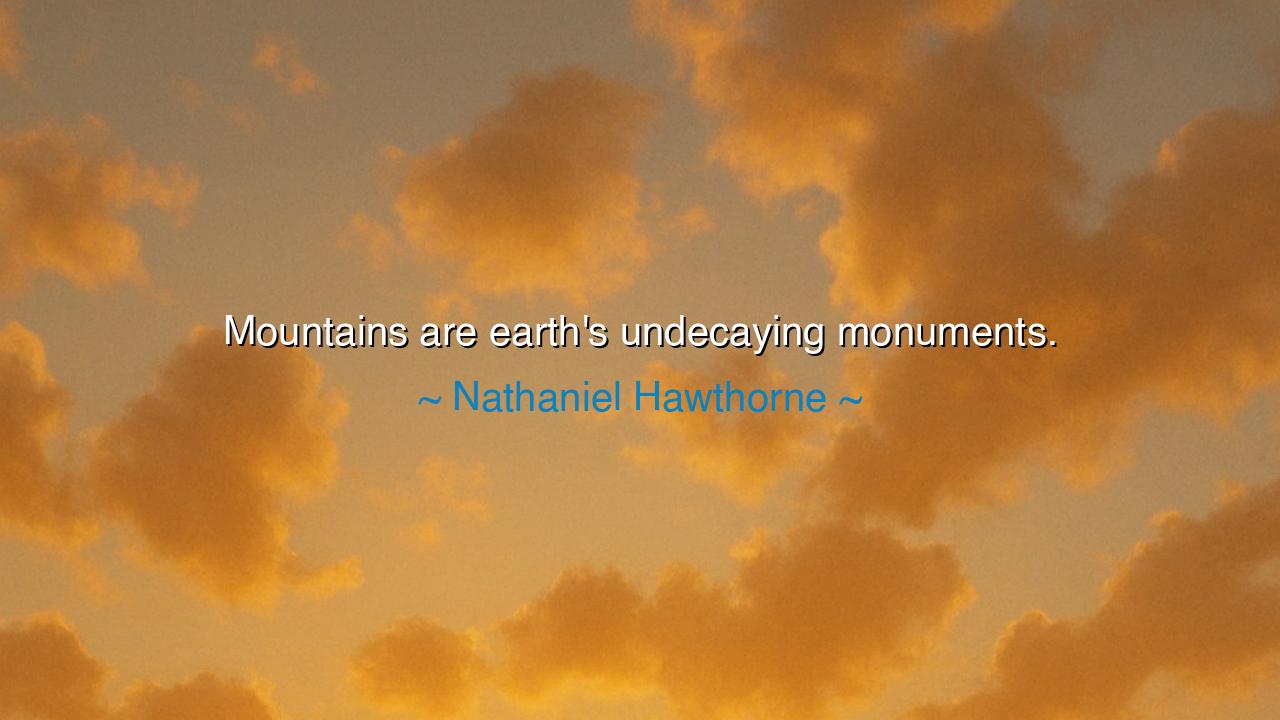
Mountains are earth's undecaying monuments.






Nathaniel Hawthorne once declared: “Mountains are earth’s undecaying monuments.” In this single line, he gave voice to an eternal truth: that while the works of man crumble, while temples, towers, and cities sink into dust, the mountains stand unmoved, as vast memorials raised not by human hands but by the earth itself. They are monuments that need no carving, no inscription, no preservation. They testify wordlessly to time, endurance, and the majesty of creation.
The origin of this reflection lies in Hawthorne’s Romantic vision of the natural world. As a writer, he often contrasted the fragility of human achievement with the permanence of nature. A monument built of stone may honor a king, a hero, or a nation, but centuries later it will erode, topple, or be forgotten. Yet a mountain—older than empires, older than memory—remains a monument not to one man, but to existence itself. It is undecaying because it was never bound to human pride, but to the deep, unshakable rhythm of the earth.
The ancients knew this wisdom. The Greeks revered Mount Olympus as the dwelling of the gods, a throne of eternity towering above mortal life. In the East, the Himalayas were seen as the seat of divine meditation, where sages touched the infinite. The Hebrews looked upon Mount Sinai as the place where heaven and earth met in fire and cloud. Across cultures, mountains have always been symbols of permanence, majesty, and the eternal. They are the true monuments—not carved by chisel, but raised by creation itself.
History gives us examples of this contrast. The pyramids of Egypt, though grand, have weathered and eroded, their golden caps long gone. The Colossus of Rhodes, one of the wonders of the ancient world, stood for scarcely sixty years before falling to an earthquake. But Mount Everest, Mount Fuji, Mount Kilimanjaro—these have stood for ages untold, enduring empires and civilizations, watching the rise and fall of kings. They are indeed undecaying monuments, humbling us with their silent testimony.
The meaning of Hawthorne’s words is therefore both poetic and moral. He reminds us that what man builds for glory fades, but what nature builds for truth endures. To set our hearts only on monuments of stone is folly, for even the grandest will one day fall. But to anchor our souls to the eternal—whether in faith, in virtue, or in reverence for creation—is to build something undecaying within ourselves. The mountains are teachers of permanence, calling us to rise above the fleeting and to live for what endures.
The lesson for us is clear: measure your life not by how many monuments you raise for yourself, but by how much of your soul is carved in permanence. Acts of kindness, words of wisdom, courage in adversity—these are undecaying monuments of the human spirit. Just as the mountains do not seek fame, yet stand eternal, so too should we live with quiet greatness, building legacies not of stone, but of character.
In practice, this means seeking endurance rather than vanity. Do not labor only for recognition, but for truth. Do not strive only for monuments of stone, but for mountains of the spirit—works of love, faith, and service that no time can erase. And when life’s storms assail you, look to the mountains: unmoved, steadfast, and enduring. Let them remind you that you too can stand firm, an undecaying monument of strength in a world of change.
Therefore, remember Hawthorne’s words: “Mountains are earth’s undecaying monuments.” Let them call you to humility, to reverence, and to endurance. For while all else fades, the mountains remain—and if you shape your soul after their example, you too will stand, unmoved and eternal, a monument not to pride, but to truth.






AAdministratorAdministrator
Welcome, honored guests. Please leave a comment, we will respond soon